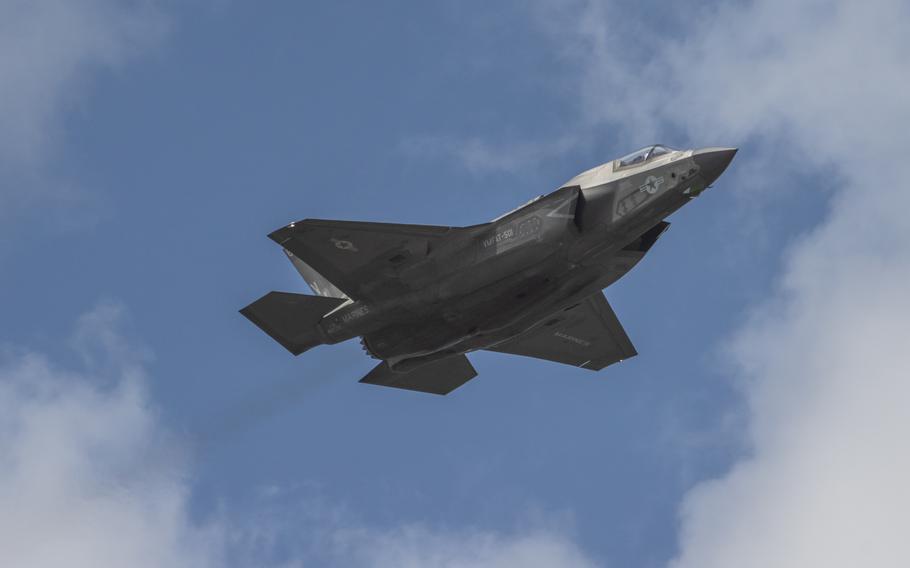
Marine Corps investigators blamed the pilot for the high-profile crash of a F-35B stealth fighter jet in 2023 near Charleston, S.C., in which the plane continued to fly more than 60 miles after the pilot ejected. (Kyle Baskin/U.S. Marine Corps)
Marine Corps investigators blamed the pilot for the high-profile crash of a F-35B stealth fighter jet last year near Charleston, S.C., in which the plane continued to fly more than 60 miles after the pilot ejected.
The pilot should have remained in the plane after experiencing electrical malfunctions while nearing his landing location at Joint Base Charleston on Sept. 17, 2023, according to an investigation dated Jan. 18, 2024, but made public by the Marine Corps on Thursday. The F-35’s “advanced automatic flight-control systems” allowed the plane to continue flying itself about 64 miles northeast onto private property near Hemmingway, S.C., where it went unfound for more than a day after it crashed, the investigation concluded.
“The pilot incorrectly diagnosed an out-of-controlled flight emergency and ejected from a flyable aircraft, albeit during a heavy rainstorm compounded with aircraft electrical and display malfunctions,” investigators wrote in the 111-page report.
Despite finding the pilot was wrong to eject, investigators recommended no punishment for the Marine in the case. The pilot’s commanding officer agreed, according to service documents.
The pilot’s name and rank were redacted in the investigation report. Investigators found the pilot was “qualified and current” to fly the advanced aircraft and he was of “sound mind and body” before the crash. The investigation described the pilot as a “highly experienced” aviator with more than 2,800 flight hours in the Marines, primarily on the AV-8B Harrier jet. But the pilot had limited experience on the F-35B, with about 32 hours flying time on that jet before the crash. The pilot was assigned to Marine Fighter Attack Squadron 501 of the 2nd Marine Air Wing.
The incident occurred at about 1:30 p.m. local time at Joint Base Charleston shortly after the pilot began procedures to conduct a vertical landing — a feature that allows the Marines’ version of the F-35B to land in a similar fashion to a helicopter. After putting his landing gear down and transitioning into vertical landing mode, the pilot reported his helmet mounted display, which provides flight information and date directly on a F-35 pilot’s helmet visor, flicked on and off at least two times.
The helmet display showed “multiple cautions and warnings” ahead of the landing attempt, the pilot reported. After the second time the instruments cut out, the pilot “determined that a runway landing was not feasible” and reverted the F-35 into its regular flight mode, he told investigators. The display flicked off again, prompting the pilot to believe the aircraft was uncontrollable and that ejection was necessary.
After the pilot ejected from the aircraft — eventually landing without major injury in a backyard in a residential neighborhood about one mile from the base — the F-35 continued to fly for 11 minutes and 21 seconds before crashing into dense forest about 64 nautical miles from where the pilot ejected. The Joint Base Charleston tower was able initially to track the jet, but lost radar contact with it after it flew about 23 nautical miles, the investigation found.
With the plane missing, Marine officials launched a massive hunt for the jet, which included military assets and civilian law enforcement. The jet would not be found until about 27 hours after the pilot ejected.
Investigators found the low flight path and the F-35s stealth features likely contributed to Joint Base Charleston’s tower losing contact with the jet. They found numerous factors including the loss of radar contact, “little to no fire” created in the crash, and the crash site’s location deep in dense forest contributed to the difficulties finding the aircraft.
Even from the sky, “the crash site was hardly noticeable,” the investigators wrote.
“The only visible aircraft part from the air was a large chunk of the engine,” the report reads.
Investigators credited the search teams with finding the F-35 and cleaning up the debris in an environmentally conscious way. The cleanup process took about one month.
No people were injured on the ground in the crash, but the Marines said it resulted in the loss of privately owned “forested land and crops.”
It also ended in the loss of the F-35B, worth about $100 million, investigators wrote.